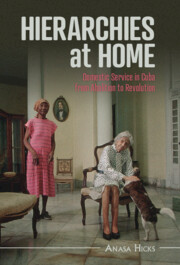Book contents
- Hierarchies at Home
- Afro-Latin America
- Hierarchies at Home
- Copyright page
- Dedication
- Contents
- Figures
- Tables
- Acknowledgments
- Author’s Note
- Introduction The Violent Intimacy of Nation-Building, Race, and Gender Inside Cuban Households
- 1 Embodied Anxieties
- 2 Of Domestic (and Other) Offices
- 3 Stopping “Creole Bolshevism”
- 4 Patio Fascists and Domestic Worker Syndicates
- 5 Pushing the Present into the Past
- 6 Conjuring Ghosts
- Conclusion
- Bibliography
- Index
5 - Pushing the Present into the Past
The Revolution’s Solution to Domestic Service in the 1960s
Published online by Cambridge University Press: 18 August 2022
- Hierarchies at Home
- Afro-Latin America
- Hierarchies at Home
- Copyright page
- Dedication
- Contents
- Figures
- Tables
- Acknowledgments
- Author’s Note
- Introduction The Violent Intimacy of Nation-Building, Race, and Gender Inside Cuban Households
- 1 Embodied Anxieties
- 2 Of Domestic (and Other) Offices
- 3 Stopping “Creole Bolshevism”
- 4 Patio Fascists and Domestic Worker Syndicates
- 5 Pushing the Present into the Past
- 6 Conjuring Ghosts
- Conclusion
- Bibliography
- Index
Summary
In 1961, as the Cuban Revolution radicalized, the newly-formed Federation of Cuban Women (FMC) created training programs for domestic servants to learn tasks like typing, teaching, and taxi driving, thereby eliminating the supply of domestic workers on the island. Members of the FMC reported that they were inspired to create schools for domestics by Fidel Castro himself, who had noticed the high attendance of domestic workers at night schools already open before 1961. This chapter investigates the history of these schools from the perspective of attendees, teachers, and counterrevolutionaries, who were suspicious of the new government’s motives. The schools for domestics, along with rehabilitation programs for prostitutes and schools for campesina (farmer) women, were emblematic of revolutionary integration of the masses into its political project. The transformation of domestic service in the 1960s reflected Cubans’ deepest fears and hopes about the revolutionary future – but the way in which the government chose to address domestic service as a labor field connected back to the republican past.
Keywords
- Type
- Chapter
- Information
- Hierarchies at HomeDomestic Service in Cuba from Abolition to Revolution, pp. 130 - 152Publisher: Cambridge University PressPrint publication year: 2022

